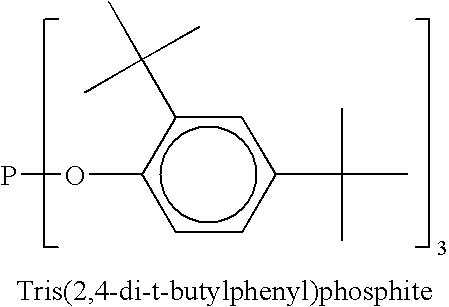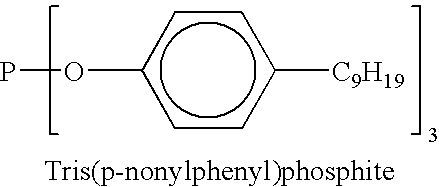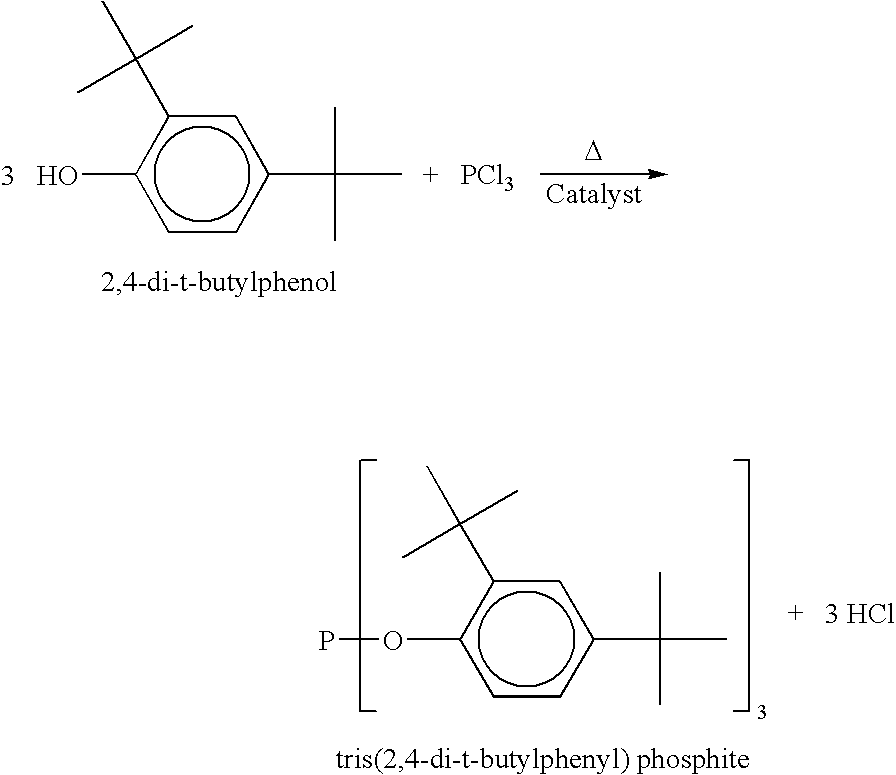Liquid phosphite compositions having different alkyl groups
a technology of liquid phosphite and alkyl group, which is applied in the direction of chemical inhibitors, chemical apparatus and processes, etc., can solve the problem that the tris(2,4-di-t-butyl) phosphite is not well-suited to the stabilization of all polymers
- Summary
- Abstract
- Description
- Claims
- Application Information
AI Technical Summary
Benefits of technology
Problems solved by technology
Method used
Image
Examples
example 1
Synthesis of Mixed Amyl / Butyl Phenols
[0176]Phenol (105 grams, 1.12 moles) and Fulcat 22B catalyst (2.25 grams) were charged to an oil jacketed flask and heated to 130° C. under nitrogen. Isobutylene (64.6 grams, 1.15 moles) was added via a sintered glass frit below the surface of the phenol at a uniform rate over 30 minutes. During addition, the internal temperature rose to 140° C. Once the addition was completed, the reaction mass was held at a jacket temperature of 130° C. for one hour. Amylene (39.2 grams, 0.56 mole) was then added below the surface of the phenolics at a uniform rate over 1.25 hours. After the addition, the reaction mass was held at a jacket temperature of 130° C. for two hours. The reaction was then filtered and the phenolic filtrate collected. The mixed butylated / amylated phenol alkylate was subjected to vacuum distillation to reduce the phenol content to less than 0.25% and the water content to less than 50 ppm. Yield=161.8 grams.
[0177]GC analysis identified t...
example 2
Conversion to a Phosphite of the Alkylate Obtained as per Example 1
[0178]Mixed butylated / amylated phenolic alkylate (148.7 grams, 0.86 mole) was charged to an oil jacketed flask and heated to 80° C. under nitrogen. PCl3 (35.8 grams, 0.26 mole) was added, below the surface of the phenolics, at a uniform rate over three hours. During the addition, the temperature was ramped to 150° C. The reaction mass was held at 150° C. until HCl evolution ceased, and then was heated to 200° C. over one hour while the pressure was reduced from 1000 to 50 mbar. The reaction was held at 200° C. / 50 mbar until the total Cl content was less than 50 ppm. The phenolic excess was then removed by distillation under one mbar pressure and an internal temperature of 240° C. (vapor temperature 140° C.). Yield=123.1 grams.
[0179]The phosphite composition had kinematic viscosity of @ 30° C. of 8,541 cSt, @ 40° C. of 3,198 cSt, and @ 50° C. of 812 cSt.
example 3
[0180]73.4 g (0.53 moles) of phosphorous trichloride and 1.74 ml (6.41 mmols) of N,N-dimethyldodecylamine are charged to a jacketed vessel under nitrogen. The contents of the vessel are agitated and heated to 70° C. Separately, a powdered blend of 193.1 g (1.18 moles) of 4-tert-amylphenol and 121.3 g (0.56 moles) of 2,4-di-tert-butylphenol is prepared. The powdered blend is added in uniform shots of 26.2 g, every 15 minutes over 3 hours. During the addition the reaction is held at 70° C. and evolved HCl is absorbed by a scrubber unit.
[0181]Once all the phenols are added, the reaction temperature is uniformly ramped from 70° C. to 150° C. over 1 hour. The reaction mass is held at 150° C. for 1 hour or until the HCl evolution has stopped. Next, the reaction mass is further heated from 150° C. to 200° C. and held for 1 additional hour. Once the reaction mass has reached 200° C., the reaction is degassed by applying a vacuum at a pressure from 60-80 mbar until the total chlorine content...
PUM
| Property | Measurement | Unit |
|---|---|---|
| melting point | aaaaa | aaaaa |
| weight percent | aaaaa | aaaaa |
| temperature | aaaaa | aaaaa |
Abstract
Description
Claims
Application Information
 Login to View More
Login to View More - R&D
- Intellectual Property
- Life Sciences
- Materials
- Tech Scout
- Unparalleled Data Quality
- Higher Quality Content
- 60% Fewer Hallucinations
Browse by: Latest US Patents, China's latest patents, Technical Efficacy Thesaurus, Application Domain, Technology Topic, Popular Technical Reports.
© 2025 PatSnap. All rights reserved.Legal|Privacy policy|Modern Slavery Act Transparency Statement|Sitemap|About US| Contact US: help@patsnap.com



